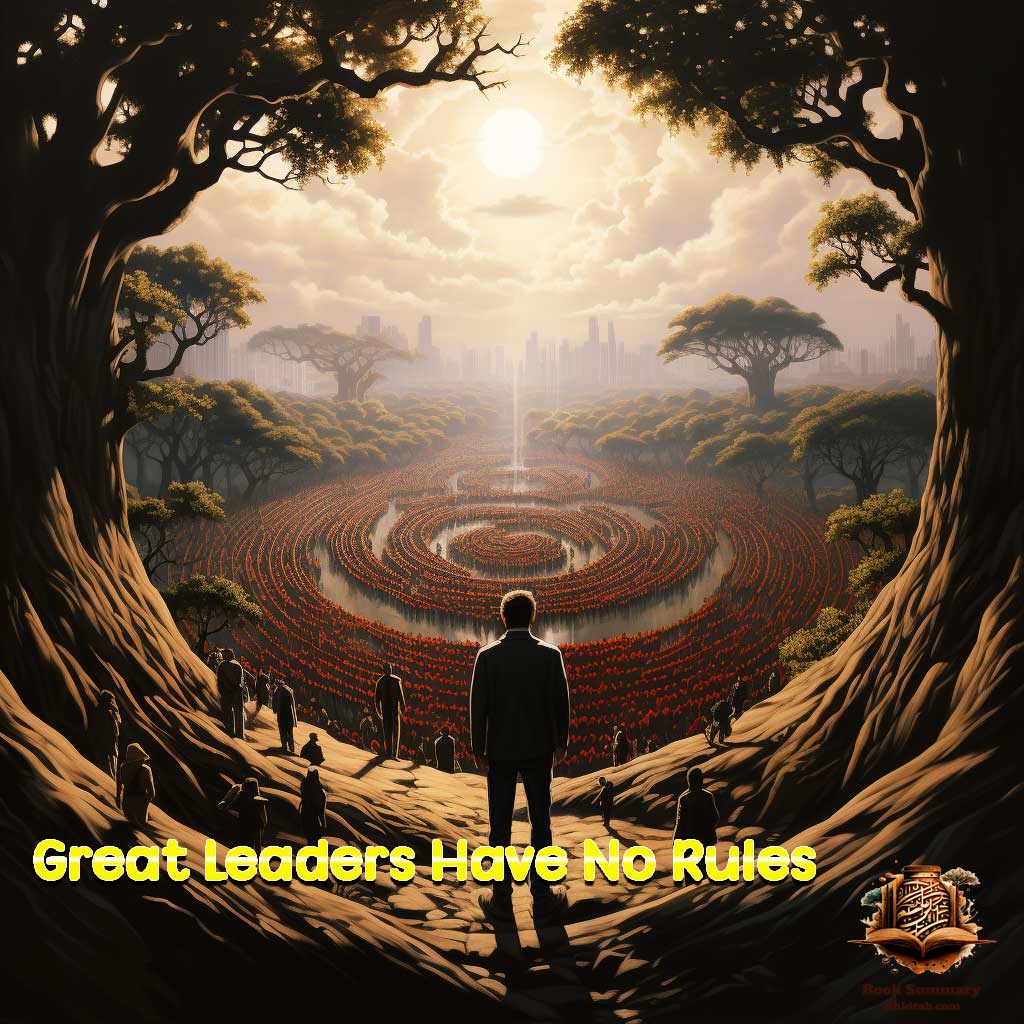Great Leaders Have No Rules: Contrarian Leadership Principles to Transform Your Team and Business Book Summary

Leadership is a multifaceted concept, one around which myriad principles and ideas revolve. But have you ever contemplated leadership devoid of traditional rules? In his book, “Great Leaders Have No Rules: Contrarian Leadership Principles to Transform Your Team and Business,” Kevin Kruse presents an unconventional perspective on the art of leadership.
This book is not merely a collection of theoretical essays and musings. Instead, it’s a culmination of practical experiences and lessons that Kruse has gleaned throughout his professional journey. Kruse delves into how leadership can be more effective when we move beyond rigid rules and embrace more flexible, human-centric principles.
For a long time, strict rules and defined policies were considered the go-to means to ensure order and stability within organizations. However, Kruse challenges this notion, suggesting that these rules might actually be impediments to creativity and growth. Through real-world success stories and vivid examples, Kruse demonstrates how thinking outside the box and relying on principles over rules can lead to far better outcomes.
Simply put, this book is an invitation to rethink everything we know about leadership and to explore innovative ways to achieve success in the contemporary business world.
Why is the Closed-Door Policy Essential for Effective Leadership?
In today’s rapidly-evolving business environment, where distractions are abundant and attention is a premium resource, “Great Leaders Have No Rules: Contrarian Leadership Principles to Transform Your Team and Business” by Kevin Kruse introduces a groundbreaking concept: the Closed-Door Policy. This might seem counterintuitive, especially when many leadership manuals and courses advocate for the “open-door policy.” So, why does Kruse challenge this widely accepted notion?
The traditional open-door policy, while fostering a sense of accessibility and communication, can often lead to frequent interruptions, decreased productivity, and a diluted focus. Kruse posits that in our quest to be approachable, we may unintentionally be hindering both our efficiency and that of our teams. With a barrage of impromptu meetings, quick questions, and unannounced drop-ins, the modern leader finds it increasingly challenging to accomplish tasks that require deep concentration.
Enter the Closed-Door Policy. This approach is not about creating barriers or isolating oneself but is about intentional structuring of one’s time. It’s about designating specific hours for focused work, free from disturbances, and other hours for open communication and collaboration. By doing this, leaders can ensure they give adequate attention to critical tasks while still being available for their teams.
Moreover, the Closed-Door Policy supports a culture where team members are encouraged to be more independent, make decisions, and problem-solve on their own. It fosters an environment where interruptions become meaningful conversations during designated times, rather than frequent, scattered, and often unproductive interactions throughout the day.
In essence, Kruse’s advocacy for the Closed-Door Policy in “Great Leaders Have No Rules” isn’t about shutting out communication; it’s about maximizing efficiency, enhancing focus, and ultimately leading teams more effectively in our contemporary, distraction-filled world.
Business & Finance Management – Book Summary (khkitab.com)
How Does Vulnerability Shape Trust in Leadership?
In the transformative work, “Great Leaders Have No Rules: Contrarian Leadership Principles to Transform Your Team and Business,” one of the standout principles discussed is the role of vulnerability in leadership. The traditional leadership mold often suggests a figure of unwavering strength, confidence, and resilience. However, this book challenges that archetype, diving deep into the unconventional wisdom that vulnerability can, in fact, be a potent leadership tool.
Vulnerability in leadership is not about showcasing weakness but about revealing authenticity. It’s about acknowledging imperfections, embracing uncertainties, and being open about one’s challenges and fears. This level of openness dismantles the facade of invincibility, making leaders more relatable and approachable.
When leaders display vulnerability, they send a powerful message: It’s okay to be human. This nurtures an environment where team members feel more comfortable sharing their concerns, making mistakes, and learning from them. Such a setting encourages a culture of trust, where people believe that their leaders understand and empathize with their experiences.
Moreover, by opening up and sharing personal stories or challenges, leaders can foster deeper connections with their teams. These genuine connections act as the foundation for collaboration, creativity, and innovation. When a team member feels seen and understood by their leader, they are more likely to invest emotionally in their work, leading to increased dedication and commitment.
In essence, “Great Leaders Have No Rules” posits that vulnerability is not a leadership flaw but a strength. By breaking down barriers and revealing the human side, leaders not only cultivate trust but also inspire loyalty and drive in their teams, essential ingredients for long-term success and growth.
Our Facebook Page – Book Summary
How Does Leading with Love Transform Team Dynamics?
In “Great Leaders Have No Rules: Contrarian Leadership Principles to Transform Your Team and Business,” a particularly captivating principle introduced is the concept of “Leading with Love.” Beyond the traditional metrics and strategic approaches often prioritized in the world of leadership, this book highlights the profound impact of genuinely caring for team members as individuals, not just as contributors to a larger goal.
Leading with love entails more than just being compassionate; it’s about deeply understanding the aspirations, fears, and dreams of each team member. By recognizing and valuing the human aspect of each individual, leaders can foster a more profound connection that goes beyond the confines of professional relationships. This deeper connection cultivates an environment where team members feel appreciated, heard, and understood, leading to enhanced loyalty and dedication.
Additionally, when a leader shows genuine interest in the well-being of their team members, it sets a tone of mutual respect and trust. Employees are more likely to be open, honest, and forthcoming about their concerns or ideas, knowing that their leader genuinely cares about their perspectives. This kind of open dialogue can lead to increased collaboration, creativity, and innovation, as team members feel empowered to bring their whole selves to their work.
Furthermore, an environment where team members feel valued and loved can significantly reduce workplace stress and burnout. A sense of belonging, coupled with a supportive leader who understands and prioritizes their well-being, can be a potent motivator. This not only boosts morale but also enhances productivity, as team members feel inspired and energized in their roles.
In essence, “Great Leaders Have No Rules” underscores that leading with love is not a sign of weakness but a strategic and compassionate approach to leadership. By putting the well-being and aspirations of team members at the forefront, leaders can create a thriving, innovative, and harmonious work environment that benefits both the individual and the organization as a whole.
How Do Clear Boundaries Empower Teams More Than Strict Rules?
In “Great Leaders Have No Rules: Contrarian Leadership Principles to Transform Your Team and Business,” a pivotal notion is explored regarding the traditional understanding of rules in the workplace. Instead of promoting a rigid framework of do’s and don’ts, the book delves into the transformative power of setting clear boundaries.
At its core, the difference between rules and boundaries is one of mindset and approach. Rules are often seen as inflexible, top-down mandates that limit creativity and individual agency. They are, essentially, a set of constraints placed on team members, telling them explicitly what they can and cannot do. This approach, while maintaining order, can stifle innovation and discourage individual responsibility.
Boundaries, on the other hand, serve a different purpose. They outline the scope within which individuals can operate, but they also leave room for personal initiative and creativity. Think of boundaries as the edges of a canvas. While they define the limits, everything within those limits is up to the artist’s interpretation. This fosters a sense of ownership and responsibility among team members, encouraging them to think outside the box, yet within a clear and understood framework.
By setting boundaries instead of strict rules, leaders are essentially telling their teams: “Here’s where we need to go, and here’s the sandbox you can play in to get us there.” This approach nurtures a culture of trust. It suggests that leaders believe in the capabilities and judgment of their team members.
Furthermore, boundaries allow for adaptability. In an ever-changing business landscape, strict rules can quickly become obsolete. But boundaries, with their inherent flexibility, can evolve with the circumstances, ensuring that teams remain agile and responsive.
In conclusion, “Great Leaders Have No Rules” champions the idea that to truly transform a team and business, leaders should shift from a rule-centric approach to one that emphasizes clear and empowering boundaries. This fosters a collaborative environment where individuals feel trusted and free to innovate, ultimately driving the success of the entire organization.
Can True Leadership Always Rely on Consensus? Understanding The Myth from “Great Leaders Have No Rules”.
In the transformative book, “Great Leaders Have No Rules: Contrarian Leadership Principles to Transform Your Team and Business,” a significant leadership myth is meticulously dissected: the unwavering pursuit of consensus. At first glance, striving for unanimity among team members seems like the ideal path. After all, wouldn’t decisions made with everyone’s agreement lead to a more harmonious workplace? This book challenges such preconceptions.
Consensus, while a noble goal, is not always practical or even beneficial. In fact, the book outlines scenarios where reaching a consensus can be counterproductive. Here’s a deep dive into this idea:
- Time is of the Essence: In fast-paced business environments, waiting for everyone’s nod might mean missing out on vital opportunities. Sometimes, immediate decisions, even if not popular, are necessary to steer the company in the right direction.
- Diluted Decisions: Aiming for a consensus might lead to a middle-ground solution that’s neither here nor there. It could be a watered-down version that pleases everyone but excites no one and lacks the impact a bolder decision might have.
- Stifling Innovation: A consensus-driven approach may suppress radical ideas that are initially unpopular but could be game-changing. History is replete with innovative ideas that were initially resisted but later heralded as genius.
- Over-reliance on Harmony: While team harmony is essential, over-prioritizing it can prevent the surfacing of vital disagreements. Sometimes, these disagreements, when channeled correctly, can lead to breakthroughs.
- Leader’s Role: The role of a leader isn’t just to amalgamate opinions but to have a vision. Sometimes, this vision might be ahead of its time, requiring a leader to guide their team toward it rather than waiting for everyone to see it.
In conclusion, while consensus has its place in leadership, it’s not the be-all and end-all. “Great Leaders Have No Rules” empowers leaders with the understanding that their primary role is not just to find a middle ground but to guide, inspire, and sometimes make the tough calls, even if they stand alone in them. Leadership is as much about conviction as it is about collaboration.
Why Should Leaders Challenge the Status Quo? Insights from “Great Leaders Have No Rules.”
In the ever-evolving business landscape, clinging to tried-and-tested methods without openness to change can spell stagnation. The book “Great Leaders Have No Rules: Contrarian Leadership Principles to Transform Your Team and Business” underscores this with a unique perspective: challenging the status quo isn’t just a strategy; it’s essential for survival. Here’s a deep dive into why:
- Adapting to Change: The only constant in business is change. By challenging pre-existing norms, leaders can ensure that their organizations remain adaptable and can swiftly maneuver in changing circumstances.
- Cultivating Innovation: A culture that encourages questioning and re-evaluation breeds innovation. When employees feel safe to think outside the box, fresh ideas flourish, propelling businesses ahead of competitors.
- Avoiding Complacency: “If it ain’t broke, don’t fix it” can sometimes be a trap. By constantly re-assessing processes, leaders can identify potential efficiencies or improvements before a process becomes outdated or problematic.
- Empowering Employees: When leadership promotes challenging the norm, it empowers employees. It sends a message that their voices and perspectives are valued, boosting morale and fostering a more engaged and committed workforce.
- Preparing for the Future: Tomorrow’s industry leaders are those who are willing to disrupt today. By being at the forefront of change, businesses can position themselves as industry leaders rather than followers.
- Diversifying Perspectives: Challenging the status quo often means seeking diverse perspectives. This diversity in thought can lead to better decision-making and richer, more creative solutions to challenges.
In conclusion, while it might be comforting to stick to “how things have always been done,” this book offers compelling reasons why leaders should foster an environment that not only accepts but encourages challenging the norm. “Great Leaders Have No Rules” is a testament to the power of innovation and the importance of constantly re-evaluating processes, mindsets, and strategies in the quest for excellence.
Why is Transparency in Leadership a Game-Changer? Insights from “Great Leaders Have No Rules”.
In today’s fast-paced business landscape, the way leaders communicate and interact with their teams holds paramount significance. “Great Leaders Have No Rules: Contrarian Leadership Principles to Transform Your Team and Business” sheds valuable light on why transparency in leadership is not just a virtue but an imperative. Here are some critical takeaways on the subject:
- Building Trust: Transparent leadership fosters an environment of trust. When team members believe their leaders are honest and open, they are more likely to reciprocate with the same honesty, enhancing the overall organizational culture.
- Empowering Decision Making: With clear communication about company strategies, changes, and potential challenges, employees are better equipped to make informed decisions. It reduces the room for ambiguity and encourages proactive problem solving.
- Enhancing Collaboration: Knowing the broader picture and understanding the ‘why’ behind decisions can significantly boost collaboration. When the team is aware of the company’s goals and challenges, they can align their efforts more effectively.
- Boosting Morale and Engagement: Employees feel valued and included when leaders are transparent about company happenings. This sense of inclusivity can be a significant driver for motivation and job satisfaction.
- Promoting Accountability: Clear communication means clear expectations. When leadership is transparent about goals, benchmarks, and performance metrics, it creates an environment where everyone understands their roles and responsibilities.
- Managing Change: Change is inevitable, but resistance to change is a common obstacle. Transparent communication about the reasons for change, its implications, and its benefits can facilitate smoother transitions and reduce apprehensions.
- Crisis Management: In times of crises or challenges, hiding or sugar-coating the truth can backfire. Being upfront, while also communicating the steps being taken to manage the situation, can rally the team together and foster a spirit of resilience.
In conclusion, transparent leadership, as highlighted in “Great Leaders Have No Rules”, isn’t just about being open; it’s about fostering an environment where information is shared, questions are encouraged, and collaboration thrives. Leaders aiming for long-term success and a cohesive team should embrace transparency as a foundational principle in their leadership strategy.
Why Should Leaders Extend Trust from Day One? Insights from “Great Leaders Have No Rules.”
Trust has been a cornerstone of leadership discussions for decades. Yet, in the book “Great Leaders Have No Rules: Contrarian Leadership Principles to Transform Your Team and Business,” there’s a novel perspective: trust should be freely given from the outset, rather than earned over a prolonged period. Delving into this seemingly counterintuitive approach, we explore the core reasons behind this argument:
- Accelerating Team Integration: By granting trust from the onset, new team members can integrate more seamlessly. They’re encouraged to voice ideas, share concerns, and actively participate without the baggage of proving themselves first.
- Promoting Open Communication: Trust fosters a culture of open dialogue. When team members feel trusted, they’re likelier to communicate openly, share innovative ideas, and provide candid feedback.
- Fostering Accountability: Counterintuitively, when individuals are trusted from the get-go, they often feel a higher sense of responsibility. They’re intrinsically motivated to uphold that trust, leading to greater accountability for their actions and outcomes.
- Building Resilient Relationships: Offering trust initially sets the foundation for strong interpersonal relationships. In the face of challenges or disagreements, these trust-based relationships tend to be more resilient.
- Empowering Decision Making: A culture where trust is the default empowers individuals to make decisions without seeking approval at every juncture, fostering a more agile and responsive organization.
- Optimizing Productivity: Trust reduces the need for micro-management. When leaders spend less time overseeing every detail, it frees up time for strategic thinking and allows team members to operate at their peak potential.
- Attracting Talent: In today’s competitive talent market, organizations known for their trust-centric cultures can have a distinct edge in attracting and retaining top talent.
- Mitigating Prolonged Suspicion: Waiting for trust to be earned can create an environment of prolonged suspicion. By giving trust freely, leaders mitigate this, fostering an environment of positivity and collaboration.
In conclusion, “Great Leaders Have No Rules” brings to light the profound impact of redefining how we view and extend trust in leadership. By flipping the script and offering trust freely from day one, leaders can catalyze organizational transformation, drive innovation, and nurture a culture where individuals feel valued and empowered.
Why is Continuous Learning Pivotal for Today’s Leaders? Insights from “Great Leaders Have No Rules: Contrarian Leadership Principles to Transform Your Team and Business.”
In today’s rapidly-evolving business landscape, adaptability and foresight are two essential skills for survival. “Great Leaders Have No Rules” delves deep into the importance of personal growth and continuous learning for leaders. Here’s a deep dive into the principles outlined:
- Adaptability in a Changing World: In an era where industries can be disrupted overnight, leaders who prioritize continuous learning are better equipped to navigate changes and adapt their strategies.
- Promoting a Growth Mindset: Leaders who are perpetual learners naturally foster a growth mindset within their teams. This mindset is characterized by the belief that abilities and intelligence can be developed through dedication and hard work.
- Decision Making Backed by Fresh Knowledge: Continuous learning provides leaders with updated information, ensuring that decisions are made based on the most recent and relevant data.
- Setting the Standard: When team members see their leaders as constant learners, it sets a standard and expectation for them to do the same. This creates a culture where upskilling and reskilling become norms.
- Enhanced Problem-Solving Abilities: With a wider knowledge base, leaders can approach challenges from various angles, ensuring more comprehensive solutions.
- Building Resilient Teams: Leaders who emphasize learning create teams that are not daunted by failures. Instead, these failures are viewed as learning opportunities.
- Attracting and Retaining Talent: In a competitive job market, organizations that offer opportunities for growth and learning are more attractive to top talent.
- Staying Relevant: As industries evolve, it’s imperative for leaders to stay updated with trends, technologies, and methodologies. Continuous learning ensures they remain relevant and effective in their roles.
In conclusion, “Great Leaders Have No Rules” underscores the profound impact of personal growth and the commitment to continuous learning in leadership. By emphasizing and embodying these principles, leaders not only enhance their personal effectiveness but also cultivate teams that are agile, resilient, and primed for success in a dynamic business environment.
Why Should Leaders Embrace Crowdsourcing Solutions? Insights from “Great Leaders Have No Rules: Contrarian Leadership Principles to Transform Your Team and Business”
In the ever-evolving world of business, tapping into the collective wisdom of teams has become a cornerstone of agile and effective leadership. “Great Leaders Have No Rules” dives deep into this idea, underscoring the significance of crowdsourcing solutions. Let’s delve into the primary takeaways:
- Harnessing Diverse Perspectives: Every team member, regardless of their position, brings a unique set of experiences and knowledge. Crowdsourcing values this diversity, resulting in well-rounded solutions that account for multiple facets of a problem.
- Promoting Employee Engagement: When employees know that their ideas are valued and considered, it boosts morale and job satisfaction. This sense of ownership and contribution enhances commitment to the company’s objectives.
- Speed and Efficiency: Crowdsourcing can be a faster way to address challenges. Instead of waiting for a few decision-makers to dictate the path forward, multiple ideas can be processed and vetted concurrently.
- Building a Collaborative Culture: Emphasizing collective decision-making fosters an environment of collaboration. Teams that often crowdsource become better at working together, sharing knowledge, and building on each other’s strengths.
- Mitigating Leadership Blindspots: No leader, no matter how astute, is free from blindspots. Tapping into the collective intelligence helps in identifying and addressing these overlooked areas.
- Encouraging Continuous Learning: As team members contribute and see how their ideas are blended with others, they gain new insights and perspectives, promoting a continuous learning environment.
- Resilience in Face of Change: Companies that habitually involve their teams in decision-making are better equipped to handle sudden industry shifts. They have a built-in mechanism to quickly gather insights from various levels of the organization.
- Boosting Innovation: A top-down approach might limit innovation to the vision of a select few. Crowdsourcing solutions break down these barriers, paving the way for out-of-the-box thinking and fresh approaches to persistent challenges.
To conclude, “Great Leaders Have No Rules” champions the paradigm shift from traditional hierarchical decision-making to the more inclusive crowdsourcing approach. Leaders who heed this advice not only empower their teams but also position their organizations for sustained success in a dynamic business landscape.


